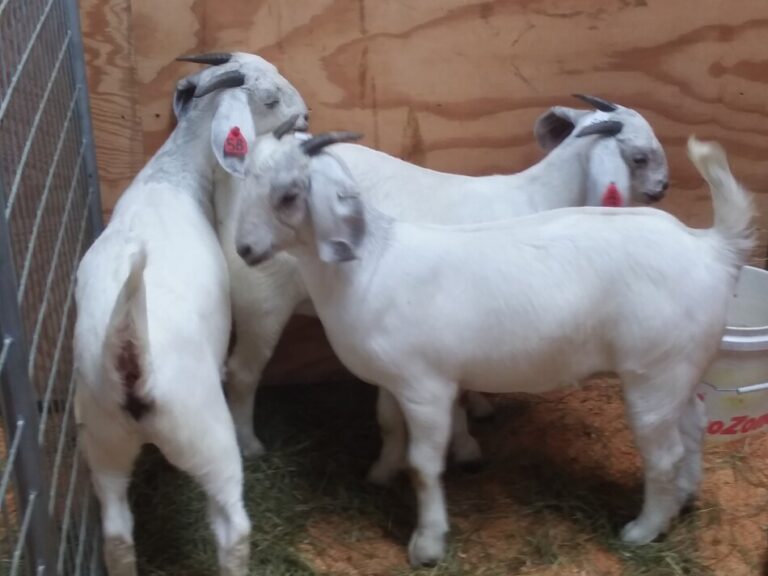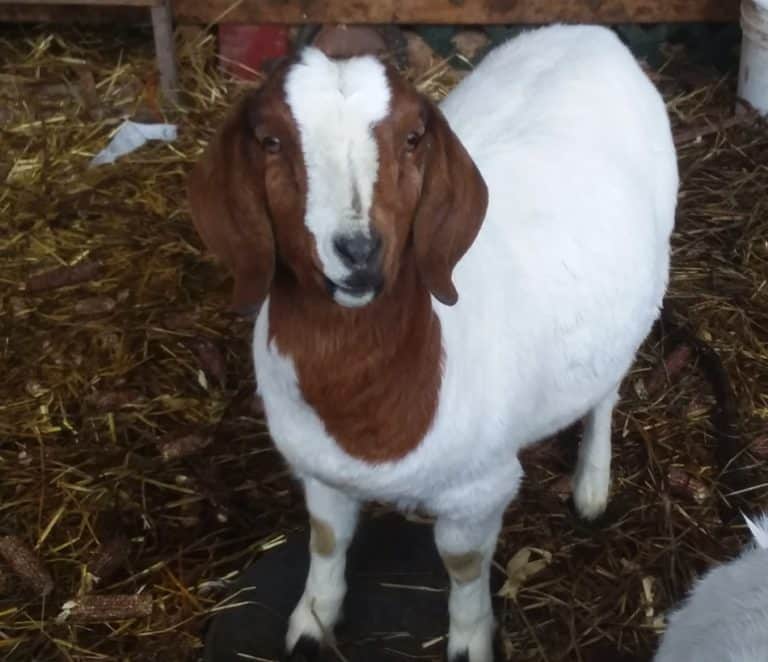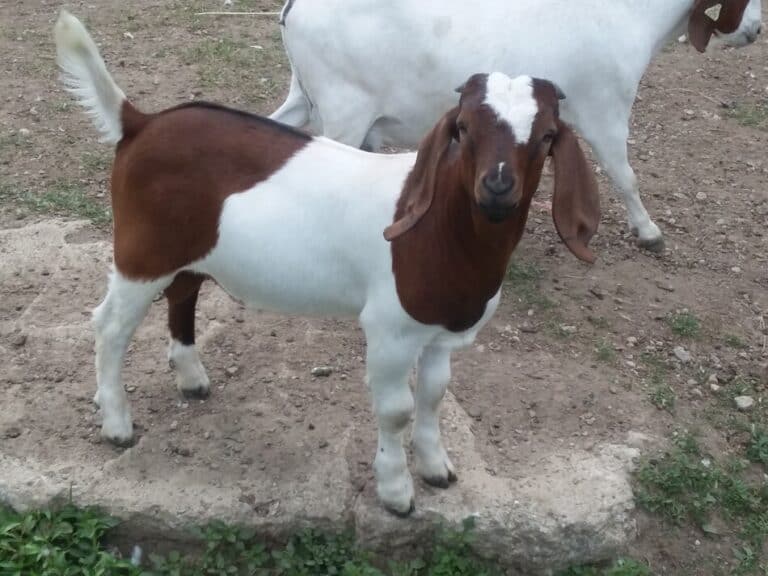Raising Goats: How To Care For Your New Herd
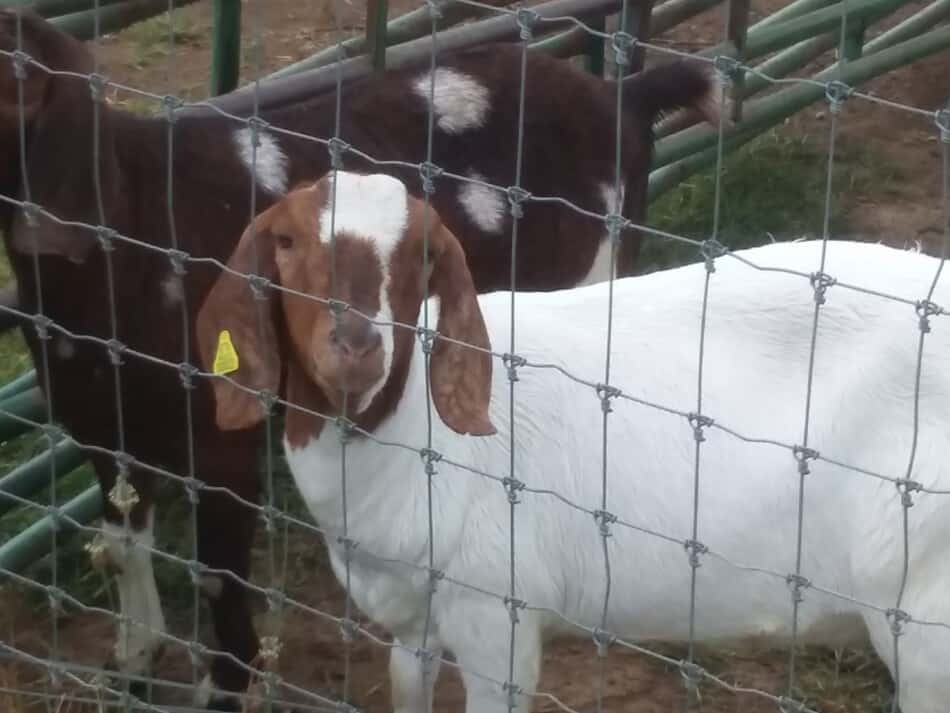
Getting new livestock is exciting! It can be easy to get so hung up on the animals that key details that are crucial for success may be overlooked.
To best care for your new goats, have feed, water and housing ready before the goats get off the trailer. Know and closely mimic their previous management schedule, especially the feeding plan.
I’ve learned a few things over the years that will help you get you off to a great start with your new goats! (And help you to avoid beginner pitfalls!)
If you want to know more about the cost to raise goats, read my article Cost To Keep And Raise Goats.
Be ready before the goats get off the trailer
Believe it or not, caring for your goats starts before they get to your farm. Have a plan. Figure out what you need and have all of your necessary items assembled and in your barn.
I’m not saying go and spend hundreds at the farm store. Look around and see what you have already.
If you are not well equipped with water troughs, hay racks, extra cattle panels, etc., buying some goat care items will be what it takes to get your goat area ready.
You’ll want to start your goats out in a quarantine pen. Even if you don’t have other goats. Keep them in a small area to get used to their new home and get to know them a bit before you give them access to a bigger area.
Goat feed can be hay, browse or grain
Hay can be fed on the ground (they’ll waste a lot) or in a feeder with a hay rack. Go with the hay rack. Our goats leave the stems that they won’t eat in the hay rack. Pull those out before you put the new hay on top.
Any grain or supplements (if needed) should be put in a feed trough, not on the ground.
Goat Feeding And Nutrition goes over caring for your goats nutritional needs.
Have some feed on hand, bales of hay and grain (if you are using it). Even if you plan to turn out your goats to pasture, let them nibble on some hay and relax first.
Remember, goats need high quality nutrition. No cheapo hay. Use whatever hay is common in your area, just make sure it is high quality.
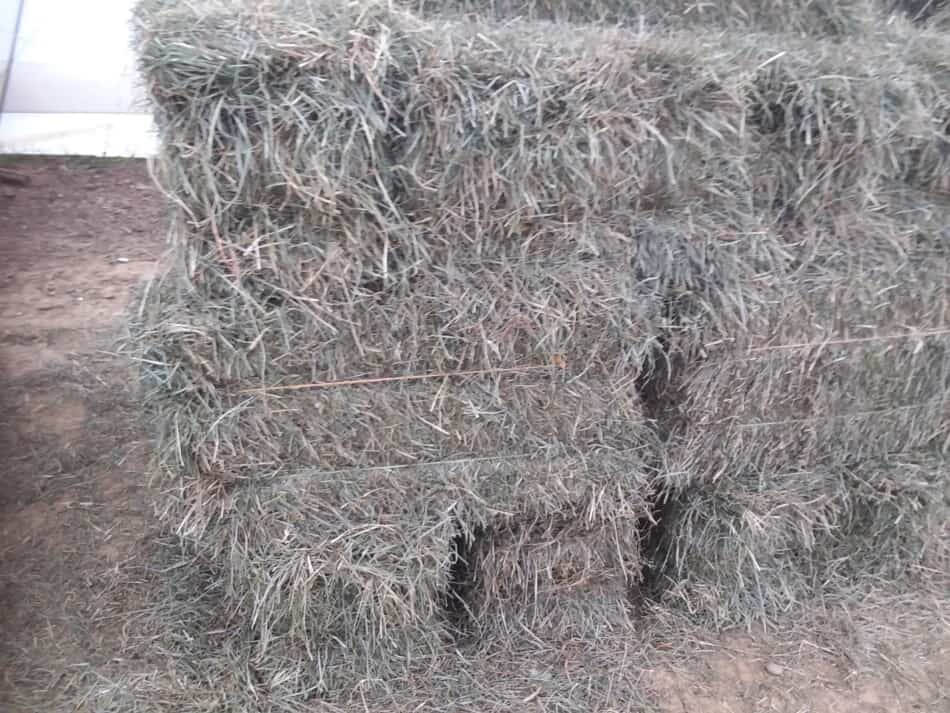
Goats eat 3.5% of their weight in hay per day
If your goats will be staying inside the barn, they need to eat about 3.5% of their body weight in hay, per day.
This is for maintenance goats, higher needs goats like growers, late gestation or lactating goats will need more nutrition.
Do the math and figure out what you’ll need. Here is an example to help you figure up your herd’s hay needs.
Goat hay needs example for a herd of 10
We’ll use a 10 head herd of goats weighing 135 pounds each that are going to need 180 days of hay feeding for the winter. They are on a maintenance ration.
To figure the daily hay needs per goat we need to take the weight of each goat and multiply by 3.5%. Be sure to use the % key or your math will be wonky.
So 135 x 3.5% = 4.7 This means that a 135 pound goat needs 4.7 pounds of hay per day.
Since we have 10 goats, the total hay for the day for the herd is 47 pounds.
Now we need to find the hay needed for the whole winter, 180 days.
180 days x 47 pounds per day= 8,505 pounds of hay for the winter
Since most places will be selling hay by the ton, take 8,505 divided by 2,000 to get the tons of hay you need for your goats.
8,505 divided by 2,000= 4.25 tons of hay for the winter
Not all hay is the same, get high quality for your goats
Please take into account that not all hays are the same and not all hay crops are the same.
What do I mean? The grasses used for hay vary in nutritional value, as does the way the hay was made. Additionally, the year will change the nutrition of hay.
Buy High Quality Hay shows you how to determine if the hay you are considering buying is worth your money!
No year is perfect for all plants. The more hay friendly the year, the better the hay will be. However, it will still vary from farm to farm and cutting to cutting.
What should you do about the variability in hay? If you can, buy from people who test their hay. Otherwise, just observe your goats and adjust.
Goats need plentiful water
If you have just a few goats, a bucket will be okay. Not great, but okay. When you can get a water trough, the kind that are short sided, 60 gallons or so.
Water is the most overlooked feed ingredient! That sounds like a crazy thing to say, but with out water, nothing happens!
Your goats can not grow to their best unless they have plenty of fresh, clean water.
How much water is that? It will vary from day to day, with hot or windy days requiring more.
You’ll need to clean out the water trough
Be sure to check the water trough for “pellets”. Sadly, animals, goats included, seem to have a knack for pooping in a water trough.
Check the water twice daily. Ask yourself, would you drink out of that trough? If not, change the water.
If the water is still full, you may think that things are great, but not so. Healthy goats with fresh, clean water will drink. If that trough is still full, dump it and give them new.
Fencing for goats is a challenge
Goats are a challenge to fence. If this is the first time you have heard or read that, you need to do more research before getting goats!
Make sure you have goat specific fencing ready for your new herd. Don’t forget that you will need a separate area for the buck when you want him to be separate from the does.
If you give your goats anything to jump on, be sure it is in the center of the area. They will use the “toys” you gave them as a playground, at first. Then they will use them to jump out!
Goats have amazing agility and love to climb. Be sure your fencing set up respects their nature and can keep them in.
Use goat specific electric netting
If you are using electric netting, be sure to get the netting specifically designed for goats. I know it is more money per roll. Get it anyway.
Goats need goat specific fencing to keep them in. Save yourself the stress and start off with the right netting.
Permanent fencing can be used for goat pastures
I am a fan of woven wire fence, the kind of fence you see with the wooden posts. Word to the wise, this is pricey.
But the huge upside for me is that woven wire fence is secure. As long as you keep the gates shut, the goats should be right where you left them.
I have seen people use cattle panels and T posts for the entire fence. This would be a great option for an area where permanent fence is hard to install or too costly when you are just getting started.
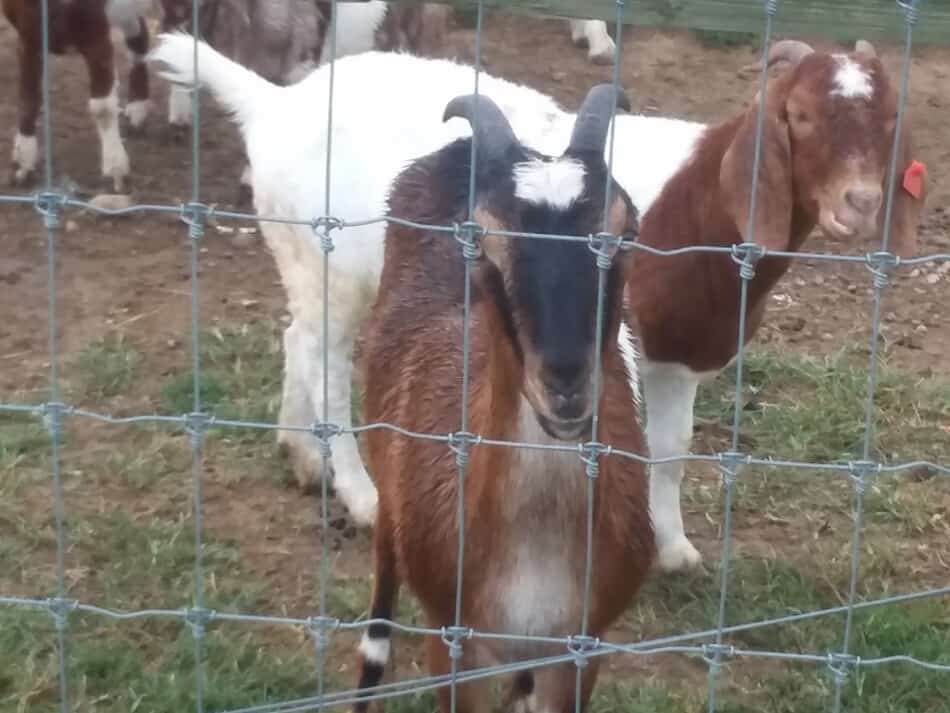
Your goats need a comfortable area
Your goats will need a comfortable place to rest. They want to be able to get out of the weather and stay dry.
Goats are not like other small ruminants.
On the plus side, goats can handle more heat than most livestock, but they still appreciate shade in the heat of the day.
Around here, we notice that the sheep get hot and head for shade much earlier in the day than the goats.
On the flip side, goats do not handle cold well. Cold and wet is even worse. Goats (unless they are really fat) do not have the external fat layer that keeps other livestock, like cattle or sheep, warm in the winter.
No external fat equals no insulation from the weather.
It is up to you to make sure your goats are comfortable in all weather conditions. The easy way to do this is to give them some choices as to where to hang out.
They will go to the place that suits them best. Even better, when the weather changes in the middle of the day, they’ll move!
Get the scoop from the goat breeder
By far the easiest thing to do, at least when you are starting out, is to copy whatever the goat breeder was doing with the goats before you bought them.
This is the management system that your goats are used to. Try it. If you don’t like it start changing some things to suit you and your situation.
The person you buy your goats from can be a tremendous resource for you and a huge help when you have a question or two about your new herd.
Responsible breeders want you to be successful with your new goats. They know the tendencies of these goats better than anyone else, let them help you.
I would take notes when you talk to the breeder about types of hay, when was the last deworming, due dates and whatever else you can think of.
Getting the goats to transition to your farm well is easiest when you make only small changes, especially to the feeding.
Heavily consider looking at this website Onion Creek Ranch. This is a goat only site that is packed full of useful information.
Be sure to read the Meat Goat Mania section, really great stuff and well worth your time.
Goats need high quality nutrition
Contrary to popular belief, goats actually need a high level of nutrition to grow well and stay healthy. (Hopefully you know all about this already.)
The challenge of feeding goats is to remember that they are really more like deer, as far as nutrition goes.
Goats, just like deer, nibble high value growing tips of shrubs and trees and eat all kinds of forbs (non grass forages) to get a nutrient dense diet. If you want good results from your goats, feeding them right is mandatory.
My goats need a bit of grain to keep weight on, yours may or may not. It depends upon the genetics of your herd. I was hoping to not need to feed any grain, but they needed it so they got it.
Be willing to adjust the herd nutrition
The reason I’m telling you this is to make sure you realize that you are starting off with your best guess as to what will work nutritionally for your herd.
When you find that you need to change the plan, adjust as needed. This is what livestock husbandry is all about!
Check your goats twice a day
Make it a policy around your farm to check your goats twice a day. Feel free to hang out with them more than that, but make sure you see them in the morning and evening each day.
Plus you get to have some relaxed time watching your herd enjoying their food or coming up for a scratch on the neck. This is one of the best parts about having goats, enjoy it!
The more time you spend with them, the better you will get at learning their “normal” behavior. This is key for situations when they are not behaving normally and you need to see what’s going on.
You’ll only be able to notice the odd behavior if you know what normal behavior looks like.
You can check your goats at feeding times
I also like to feed twice a day. This is especially helpful if you need to give the goats a two types of hay. Putting two types of hay in the feeder at once is basically asking them to waste the one they like least.
Splitting up the hay by giving all of one kind in the morning and all of one kind at night, helps them decide to like what they have been given!
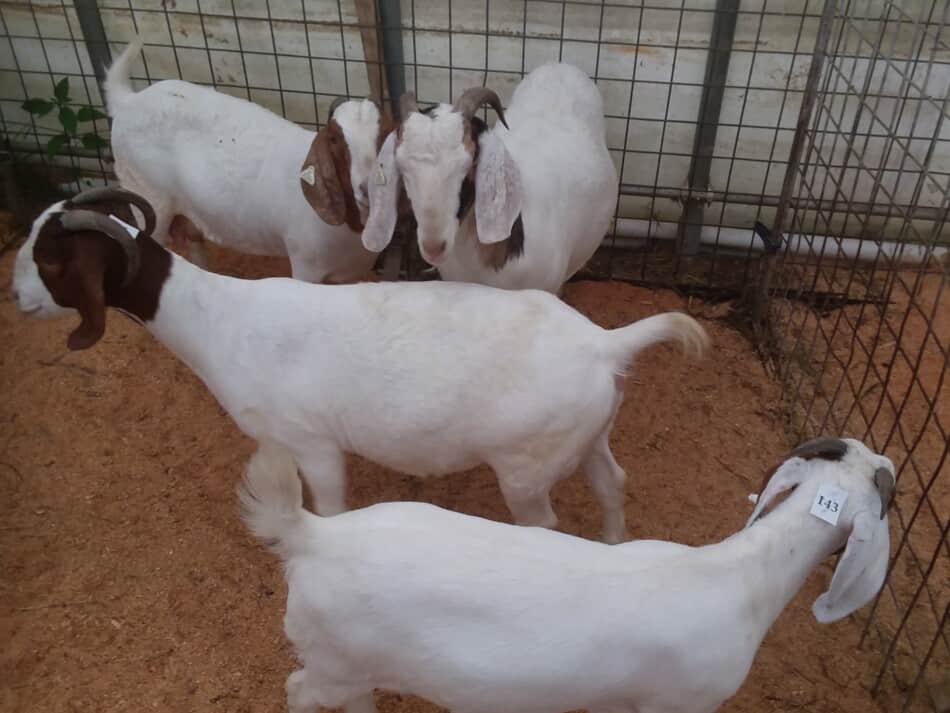
Goat genetics determine results
The genetics of your goats will determine the abilities of your herd to flourish under certain circumstances, like range conditions, grazing only, brush clearing, or living in the barn.
If you have a certain situation that you want your goats to perform under, like contract grazing, get goats that are genetically suited to your plan.
If you already have your goats, realize that they have needs and limitations and you need to fit your care to your goats.
For example: if you have Boer type goats, plan to feed them a bit of grain to keep up with their weight. If you don’t want to supplement with grain, get a different type of goat.
Kiko type goats, on the other hand, can do fine without grain, if that is your main concern. However, they have a different body type than the Boer, which might be okay for you and might not.
Plan your goat management year
You’ll need to have an idea of when you want the “big things” in your management year to happen.
These are things like the start of breeding season, when kidding should start and when you want to have market kids that are big enough to sell.
The reason you need to know these times is so you can plan for them and have your goats in top shape.
What is top shape? Well, that depends upon what goats you are referring to.
Here are some examples:
About a month before breeding season, go over your breeding stock. Are they in good condition (fat wise)? Do they need feet trimmed, dewormed or anything similar? Now is the time.
If you are going to flush the does (feed a bit of extra energy to make sure conception rates are high), that should be happening now, as well.
Don’t have a buck? You need to get started on your buck search far earlier than one month before breeding season! I would want to have the buck at my place 45 days or so before you need him.
This means you’ll need to start your search for a buck 3 months ahead of needing to use one. Three months will give you the time to search for high quality, not panic buy the first one you come across.
Important dates can sneak up on you if they are not on your calendar
As you can see, these important dates can quickly sneak up on you and leave you scrambling, not good.
Plan out what you need and by when, then put it on your calendar! This is the part that gets overlooked, put it on the calendar!
A common example here would be if you need a new breeding harness and forget to order it until the last minute. Will there still be the harness and the crayons you need in stock?
Don’t think I’m making this up, this happened to us last year with the sheep. We waited until the last minute to get 5 new harnesses, yikes!
We ended up with a kind that was inferior to our normal one, all because we let the dates slip by us. Order early.
Here is a list of the goat management actions that you need to have planned:
- Where you will be selling your goats (this includes having the right type of goat at the right size at the right time of year for your area, this requires research)
- The start of breeding season (to hit the dates above)
- The start of kidding season
- Weaning
- Deworming
- Pasture rotation
- Feeding program (all seasons of the year)
- Where to get your feed
- Watering system
- Record keeping (including tags)
- Separate pens as needed (kidding time, taking out buck, pen to load out of, hospital pen, etc)
- Culling time (when and why)
Let me be very honest here, you won’t be able to figure it all out exactly right for your first few years! We are not aiming for perfect here.
The point is to make sure the basics are “on your radar” so when surprises happen (and they will happen) you will be best able to handle them.

Management of hobby goat herds
Maybe you read the list above and thought “Wow, that seems like overkill. We just like goats.”
If you are more of a casual goat raiser, good news, the calendar has much more flexibility for you and your herd. You’ll still need to do some planning, of course, but your management can have tons more wiggle room built in.
Separate out the buck and intact bucklings
I would caution you regarding when the bucks are in with the does. You don’t want does kidding whenever or for doelings to be bred before they have the size to support the pregnancy.
This means keeping the buck and any weaned intact bucklings separate from the herd.
Additionally, the biggest challenge I see with hobby goats is they tend to get fat. Let’s face it, goats are great beggars! Stay strong and keep your herd on a tighter ration, they will be healthier for it!
Start with the basics and observe your goats
The best thing you can do is to spend some time with your goats. Learn how they act normally. Which one is the boss, which one is timid? Who’s the first to the gate to greet you?
The answer to each question does not matter, what does matter is that you know the answers so you’ll notice when something changes.
Record any goat care
You should keep track of any care that you give to the goats, whether for individuals or the group. Activities like deworming or when you turn in the buck should always be planned and recorded to help you keep track of your herd.
Sometimes animals do need individual care, like hoof trimming or antibiotics. If you need to administer care to one of your goats, write it down.
You’ll notice over time that some animals rarely need additional care, whereas others routinely need care on top of what the rest of the group needs.
These are goats that you should consider culling, since they are taking both extra time and effort that their herd mates do not require. The catch is that it’s easy to forget when you did what. Put it in your records.
Put on the calendar future care
Another key management tool is the calendar. As crazy as it may sound, get a calendar and use it. Write down what you did and schedule any follow up activities.
If your goat care activity was deworming, note the name of the dewormer and the dose you gave. This will help you keep track of your management and give you information to tell a vet, when you call.
Use a vet that knows goats
While we are talking about vet care, do a bit of research and find a vet that has some goat/small ruminant experience.
This is important to figure out before there is an emergency.
Nothing wrong with a large animal vet, he or she will be able to help you. A small ruminant vet will have more experience with your specific type of animals and be familiar with the special needs and challenges of raising goats.
